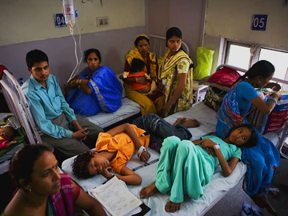 WASHINGTON: India has made great strides in reducing both child and adult mortality since 1990, according to a new study that found adults and children in the country are living longer and healthier lives than two decades ago.
WASHINGTON: India has made great strides in reducing both child and adult mortality since 1990, according to a new study that found adults and children in the country are living longer and healthier lives than two decades ago.
The first-ever journal publication of country-specific cause-of-death data for 188 countries found people are living much longer worldwide than they were two decades earlier, as death rates from infectious diseases and cardiovascular disease have fallen.
Given the size of India’s population in particular, and projections that it may soon become the world’s most populous country, mortality trends there have global implications, researchers said.
In 2013, India accounted for 19 per cent, or 10.2 million, of the world’s deaths. The country has made great strides in reducing both child and adult mortality since 1990.
The average yearly rates of decline in mortality have been 3.7 per cent per year for children and 1.3 per cent per year for adults.
Between 1990 and 2013, life expectancy at birth increased from 57.3 years to 64.2 years for males and from 58.2 years to 68.5 years for females.
“It’s very encouraging that adults and children in India are living longer and healthier lives,” said Dr Jeemon Panniyammakal of the Public Health Foundation of India and a co-author of the study published in The Lancet.
“But India’s growing influence on global health means we must do more to address the diseases that kill people prematurely,” said Panniyammakal.
Panniyammakal was part of an international consortium of more than 700 researchers led by the Institute for Health Metrics and Evaluation (IHME) at the University of Washington.
Causes of death vary widely by country, but, at the global level, drug use disorders and chronic kidney disease account for some of the largest per cent increases in premature deaths since 1990, the study found. The study found that death rates from some cancers, including pancreatic cancer and kidney cancer, increased.
At the same time, countries have made great strides in reducing mortality from diseases such as measles and diarrhoea, with 83 per cent and 51 per cent reductions, respectively, from 1990 to 2013.
Globally, three conditions – ischemic heart disease, stroke, and chronic obstructive pulmonary disease (COPD) – claimed the most lives in 2013, accounting for nearly 32 per cent of all deaths, researchers said.
Researchers found the average age of death increased from 46.7 in 1990 to 59.3 in 2013.
Partly because of global population growth, the number of deaths in both sexes for all ages combined increased from 47.5 million to 54.9 million.
The number of people dying from certain conditions, such as heart disease, has increased as population has increased, but decreases in age-specific mortality rates for these conditions is a sign of progress.
Death rates from most cancers, including breast cancer, cervical cancer, and colon cancer, have decreased, but the reverse is true for pancreatic cancer, kidney cancer, and non-Hodgkin lymphoma, researchers found.
“People today are less likely than their parents to die from certain conditions, but there are more people of older ages throughout the world,” said IHME Director Dr Christopher Murray.
Global life expectancy for both sexes increased from 65.3 years in 1990 to 71.5 years in 2013, and women made slightly greater gains than men.
Female life expectancy at birth increased by 6.6 years and male life expectancy by 5.8 years. If trends seen over the past 23 years hold, by 2030 global female life expectancy will be 85.3 years and male life expectancy will be 78.1 years.
The study found that life expectancy gains in sub-Saharan Africa were mainly driven by reductions in deaths from diarrhoea, lower respiratory tract infections, and neonatal disorders.
Reductions in cardiovascular disease, some cancers, transport injuries, and chronic respiratory conditions have led to the longevity gains in high-income regions.
Diabetes, other endocrine disorders, and chronic kidney disease decreased life expectancy across many regions, including central Latin America; mental disorders had a negative impact in multiple regions, especially North America; intentional injuries reduced life expectancy in South Asia, the high-income countries of the Asia Pacific region, and southern sub-Saharan Africa, the study found.
In Eastern Europe and Central Asia, cirrhosis took a toll on life expectancy. HIV/AIDS was a major cause of death in Southern sub-Saharan Africa and to a smaller extent in Western and Eastern sub-Saharan Africa.–PTI






